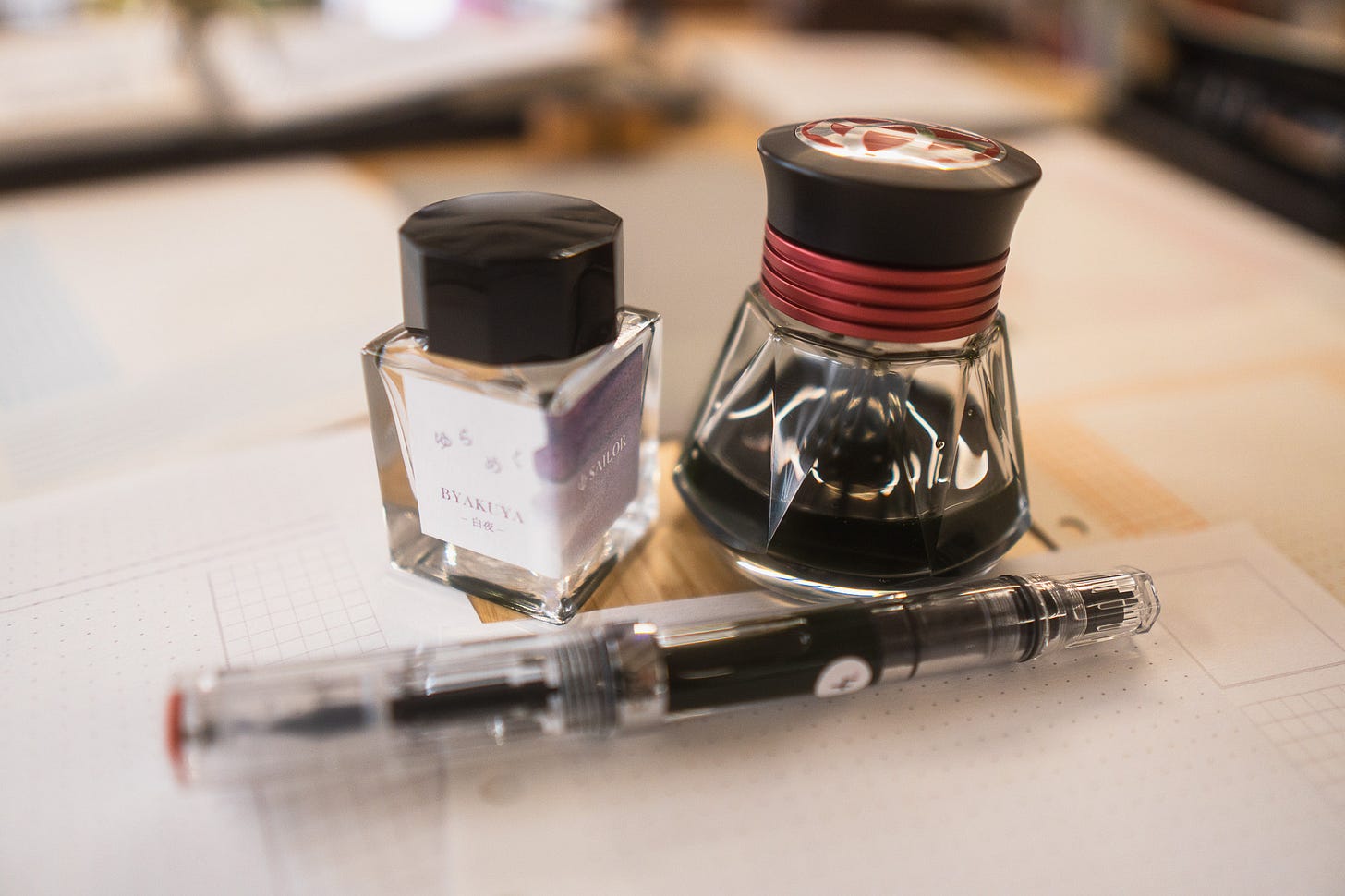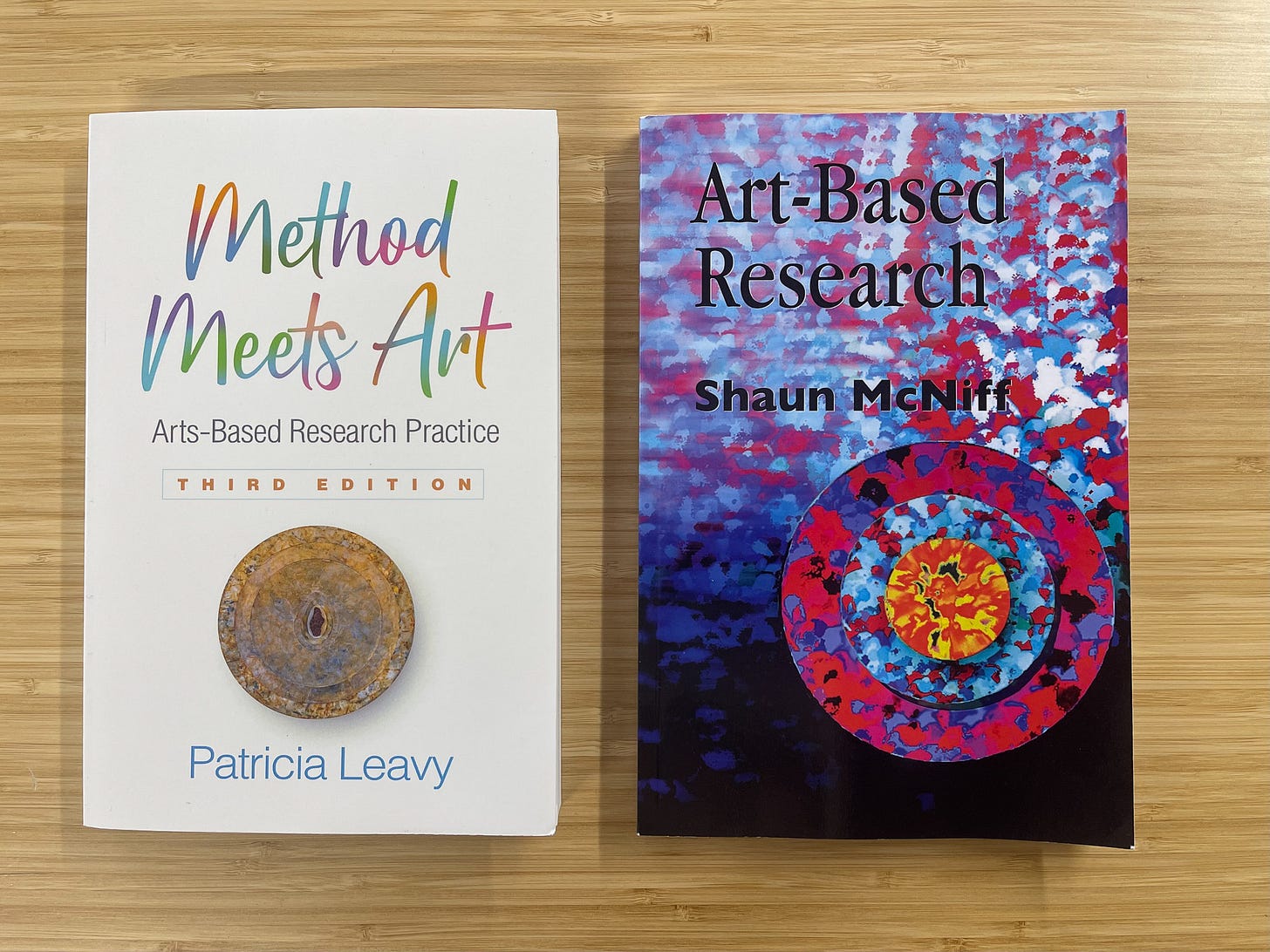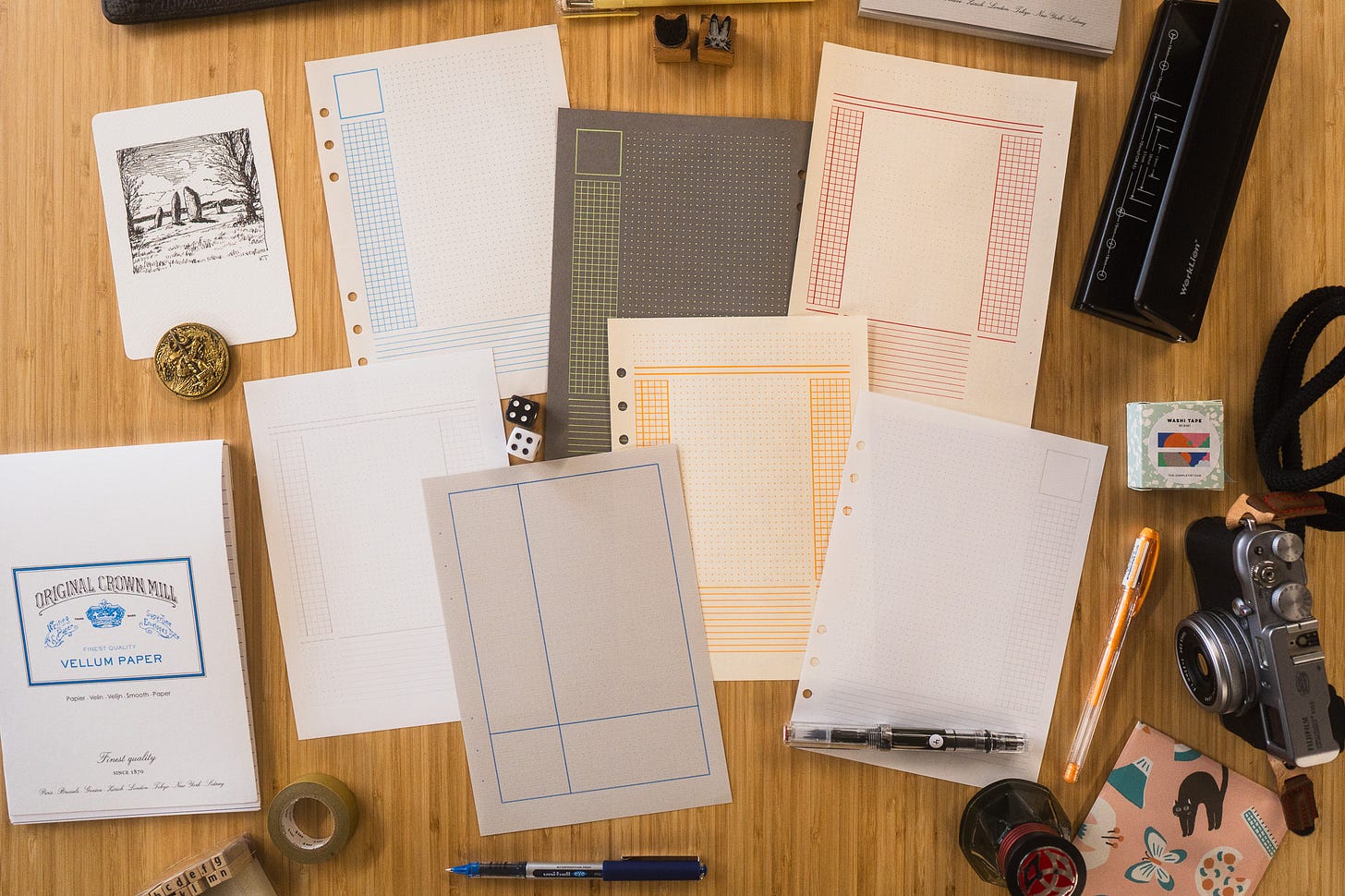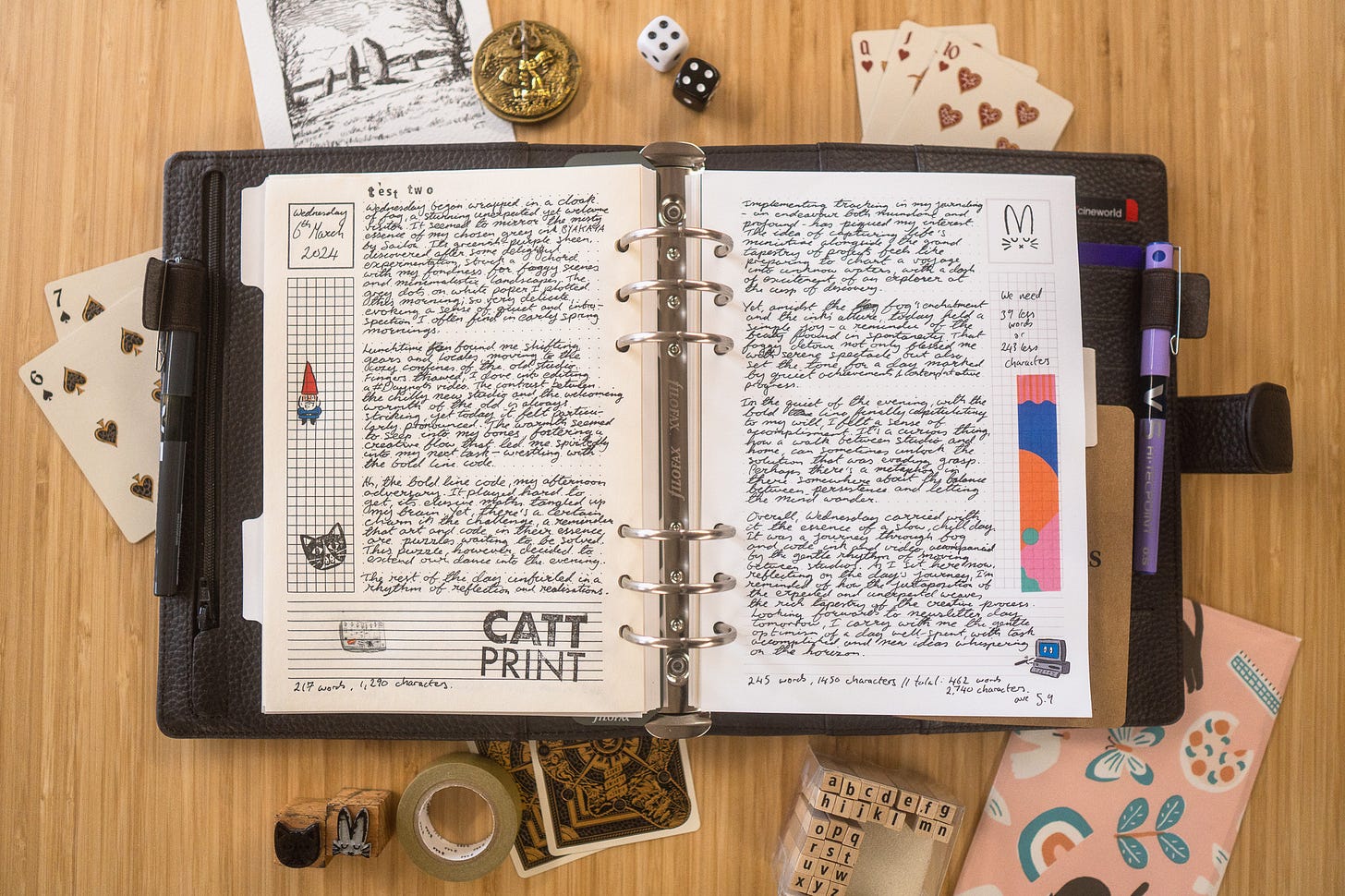📙 #030 - Arts-Based Research, may contain swearing
What actually is arts-based research, what am I researching, am I going to get Kitty to do all the work (yes), and some fancy journaling page layouts, plus swearing.
# ARTS-BASED RESEARCH
I've spent the last two weeks trying to work out what "Art-Based Research" (and practice-based research) is and what the fuck I'm doing. I have answers! The best way of explaining is to work chronologically backwards from where I am now, then how I got here, and some useful (I hope) definitions at the end. But first, I wanted to open with this quote...
'Be fearless. Worry less about being "good" and focus on being engaged. Be fully present in the process. That's the best any of us can do. Once you release a piece of work into the world, make peace with it. Your work will never be all things to all people, so it's important to learn to let go and accept that you have your own relationship with your work, and others will have theirs. Finally, have fun. Just as learning should be a joyful process, the research process can be joyful too. Sure, there will be ups and downs and a lot of hard work, but the work itself can be engaged, pleasurable, and rewarding. People often hesitate to say ABR can be fun because they are afraid it waters it down or makes it appear less rigorous. If you're having fun, I don't think it means you're not serious, I think it means you're on to something. Remember, Einstein said, "Creativity is intelligence having fun."'
- "Method Meets Art" by Patricia Leavy.
## Where I am now.
My research aims to look into how drawing machines (and AI) can help people who can no longer physically write, write. AI helps them compose what to write, and the drawing machine does the writing, and some code to reproduce their handwriting. Ultimately, I'd like to use AI to reproduce their handwriting, but that's outside of the one-year scope of this research.
This isn't what I thought I'd be researching. At the start of the last two weeks, I thought it was something else.
## How I got here.
The problem I was initially trying to solve was how to stop doom-scrolling on social media, which took up much of my time.
I decided the main cause of this problem was when I went to post something on X/Twitter, I'd end up scrolling and scrolling and scrolling, so adding a buffer between me and the posting interface was a solution.
That buffer was Kitty (my AI PA). Kitty would interrupt me throughout the day to ask what I was working on. Then, she'd compose some potential tweets and interrupt me again to pick one, which she'd then post.
I would tell Kitty, and Kitty would tell Twitter. Doom-scrolling averted, productivity enhanced, awesome.
This system slowly expanded. At the start of the day, Kitty would ask me what my plans were. During the day, Kitty would interrupt to ask how things were going. Then, at the end of the day, I'd be asked a few more questions reflecting on how everything had gone. The previous few days' questions and answers would be fed back into the AI, so the questions would evolve and stay relevant over time.
Then, I looked at other admin tasks that were a cognitive bottleneck and got Kitty involved with those, too. At the same time, I was working on getting the drawing machine to write with natural-looking handwriting while also encoding my own so I could get Kitty to write for me.
Two weeks ago, I thought the question I was researching was, "How does an artist use AI to help them manage an art studio?" I was wrong.
## A bit of a twat
Also, I was worried.
Kitty now knew enough about my day-to-day work activities and how I wrote in style and substance that if I asked her to write a letter to a friend, she could do a pretty good job.
I was wondering what this meant or how I felt about it. Would I be automating friendship?
When thinking through an idea or a script for a video, I often imagine I'm being interviewed. In this case, an imaginary interviewer incredulously asked, "So, you're thinking about being reminded of friends ' birthdays by AI and using AI to write letters and postcards to people? Aren't you being a bit of a twat?"
Typically, my imagined interviews go better than this.
I spoke with a friend who helped me reframe using AI like this from automation to augmentation and the drawing machine from robot to extension of myself, a prosthetic writing arm if you will.
My response in the interview now became, "Imagine a grandma, 70s, sharp as a button, but her fine motor control is going. She's spent her life writing letters to keep in contact with her friends, and she writes journals to remember everything. She wants to tell her friend Margot that her petunias are doing fine, and she's on her third run-through of Baulder's Gate and still hasn't had sex with a bear (Margot's has been asking you see)
"What if we could encode her handwriting before she lost her ability to hold a pen firmly? What if she could tell an AI what she was doing each day, so when it came time to write that letter to Margot, she could work with the AI to compose a letter and then have it written in her own handwriting?
"She could still have the pleasure of writing, sending letters, corresponding, journalling. What would that mean for someone? What does it mean when we give back (or give) someone the ability to express themselves in 'handwritten' letters, or how are they disenfranchised when they can't?
I wouldn't be so much of a twat then, would I!!!"
Finally won my imaginary interview, go me!
## Arts-Based Research
I will not go out and workshop letter writing with a bunch of old people or anyone else who has lost the ability to write.
I am going to continue the practice of using AI, drawing machines, and handwriting in my own art, documenting it, and interrogating it (also with the help of AI).
I believe "performative autoethnography" is a phrase I can use to a) seem smart and b) roughly describe what I'm doing using fancier academic words.
Pinning down what Arts-Based Research (ABR) is is kind of tricky. Predictably, there's no consensus; it's fairly recent, and the definitions have changed over that short time. A book published 12 years ago talks about it differently from one published two years ago, and I have most of the books published between those two times.
Here are three definitions that make it easier to say what ABR is and isn't.
Research of the Arts: when you research some arts!
Research for the Arts: researching new materials or methods that will allow you to do more/different art. I think Stewart Semple often falls into this category with his research into paints like "The Blackest Black." Inventing new materials allows new art techniques to be used and new art to be created. New sculpting substance = new sculpting methods = new sculptures.
Research in the Arts: "The artistic practice itself is an essential component of both the research process and the research results. This approach is based on the understanding that no fundamental separation exists between theory and practice in the arts" - Borgdorff, 2012
Four more slightly wider definitions (sorry)...
Practice as research: The research consists entirely of the creative practice, with no critical output deemed necessary.
Practice-and-Research: Creative artefacts and critical outputs are disseminated separately, while knowledge acquired from the create practice informs the critical explorations. - For example you may write a poem, and in the process gain knowledge that helps you study someone else's poem. The output would be your poem, and say an essay about the other person's poem.
Practice-led Research: Focus is the nature of creative practice, leading to new knowledge of operational significance for that practice. Results may be communicated in a critical exegesis without the creative artifact.
Practice-based Research: Creative artifact is the basis of the contribution to knowledge. This method is applied to original investigations seeking new knowledge through practice and its outcomes, disseminated through both the artifact and the critical exegesis
— Slide 3 of The Practice of Research: A Methodology for Practice-Based Exploration of Digital Writing
From the first three definitions, the third one, "Research in the Arts", is ABR, while the first two aren't. From the second set of definitions, I'm leaning towards 1 being closer to pure ABR and 4 being the type I am interested in.
By combining "1. Research in the Arts" and "4. Practice-based Research," we get that the artistic process is an essential component of both the research process and the research results, which will produce both artefacts and critical exegesis.
In my case, the artefacts will be pen plots, while the "exegesis" will be YouTube videos, social media posts, a journal and possibly a monograph at the end of it all.
With all that said, I've only been looking into this for two weeks now, and I still have much to read, so this may change. But for the moment, this is where I am. Of the books I have, I think these are the two most helpful in getting started.
# JOURNALING
In addition to the above book reading, I've also been looking into journaling.
As previously mentioned, Kitty has a pretty good idea of what happens to me during the day. She has access to morning Q&As, end-of-day Q&As, various notes throughout the day, and the transcripts of the #Daynotes and #Weeknote videos I'm publishing.
Unsurprisingly, when asked for a daily journal of around 420 words, Kitty is pretty good at creating an entry for me.
Anyway, the first step was creating software that allowed me to quickly create journaling page layouts, which combine dots, grids and lines. One thing I love about having access to a drawing machine is the ability to throw in pretty much any combination of pen and paper to make the pages. Otherwise, you're limited to putting regular paper through a printer, which is excellent, but we have more options.
After a little bit of testing, I've found I love the Byakuya ink from Sailor. Hold on, ChatGPT says...
In the Sailor Yurameku ink collection, the name "Byakuya" translates to "night under the midnight sun," evoking the imagery of a polar night when the sun never sets. Byakuya is a light, muted color fountain pen ink known for its mysterious quality, showing glimpses of different colors in shades and streaks. It is described as very pale and difficult to read.
lol.
Difficult to read, maybe, but paired with Crown Mill white vellum paper, you get a lovely delicate shade that works really well for dots and grids that aren’t too in your face.
I think what I'm doing all kinda makes sense; I hope so anyway. The aim at this point is to get Kitty to draw the page layouts and write the entries using her drawing machine but my handwriting.
Because I haven't finished encoding my handwriting yet, I'm writing these by hand at the end of each day to get a feel for what it's like; crampy and spider-like.
# NEXT STEP
Way back, I said I needed to write an artist's statement, but I wanted to understand what I was researching and do more research. Now, I have the next step, which is to turn that into an artist’s statement.
This means I'll end up with an artist's statement and a research goal, which will be different but aligned. Regardless, I'll be taking what I've learnt over the last two weeks, this book "Art-Write" by Vicki Krogn Amorose, and some help from Haiver (although he doesn't know that yet) to craft a statement just in time for the next newsletter. It's not planned; it just happens to fall that way.
# THE END
This is a bit of a long, more academic newsletter this time. I hope it wasn't too much. I expect I'll be taking the contents of this and turning it into a blog post and a video. This has been the first time I've had a chance to sit down and pull all my thoughts together about it. It's a little rough, so thank you for sticking with me while I try to make it make sense.
Honestly, I still don't know what I'm doing 😅
I'll include the links to the books below, which should take you to the correct Amazon store, although these things can be about 50/50.
'till next time, I love you all,
Dan
❤️
# BOOKS
Method Meets Art, Third Edition: Arts-Based Research Practice - Patricia Leavy
Art-Based Research - Shaun McNiff
Art-Write: The Writing Guide for Visual Artists - Vicki Krohn Amorose
👆 - may contain money making affiliate links, not that they have ever have.







